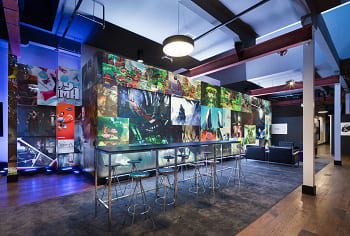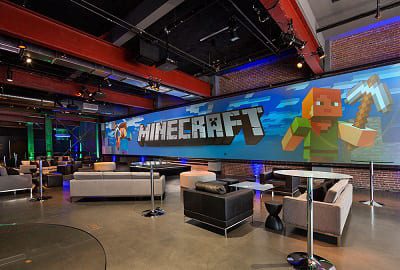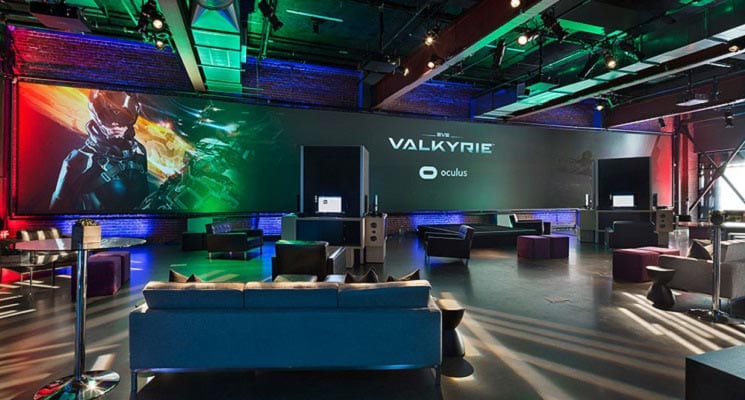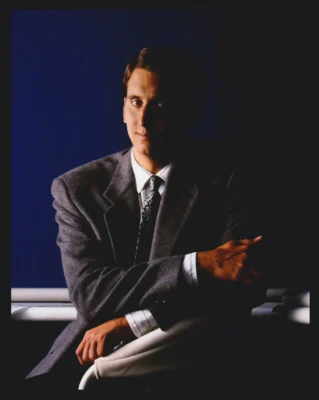In Latest Trends, Lounges Replace Conference Tables by Cynthya Porter
Walking the show floor, one used to be able to easily recognize the great many exhibits using rented furniture, mostly because it all looked more or less the same. For the small booths especially, and even in large exhibits where significant effort had been poured into design details, plain rental furniture was de rigueur–its role merely functional and its chrome and vinyl blandness screaming “after thought.”
Exhibitors wanting a more custom look doled out barrels of cash to buy the furniture, store it, repair it, and ship it to the show floor time and again–married to a look for as many years as it took to get a new-furniture line item on the budget. For many, the headache and expense were better than the alternative, however, which was having furniture that matched everybody else and suggested they ran out of design steam by the time they got to the booth’s furnishings.
 But those days are over thanks to a veritable explosion of firms cultivating sometimes massive inventories of pieces available for exhibitors to rent. They are spread from one coast to another, most of them transitioning to trade shows from the event, office, or movie set rentals business once they realized that exhibitors were interested in upping their style game too.
But those days are over thanks to a veritable explosion of firms cultivating sometimes massive inventories of pieces available for exhibitors to rent. They are spread from one coast to another, most of them transitioning to trade shows from the event, office, or movie set rentals business once they realized that exhibitors were interested in upping their style game too.
That shift is part of a larger design evolution happening at trade shows, said Kevin Dana, executive director of marketing and product development at CORT Events, one of the nation’s largest and oldest rental furniture providers. It used to be that exhibits exuded a very business-like atmosphere and far more importance was placed on function rather than form when it came to furniture. “In the mid-2000s, the market really changed and CORT changed along with it,” says Dana. “Furnishings became integral to helping support a client’s overall brand and message.”
Fritz Williams, founder and president of FormDecor, agrees. As another of the country’s largest and best stocked rental furniture providers, FormDecor has set itself apart in the industry with an inventory of unique, heavily stylized pieces that Williams say exhibitors are clamoring for today. “In the past, furniture was the very last thing on the list and not considered to be an integral part of the booth design,” says Williams. “Now companies understand it builds their brand and furnishings have become an important part of their brand story.”
Mid-century modern, old Hollywood, rose gold glamor, Danish modern, and industrial chic are among the looks trending as exhibit design themes, both owners say, and there are rental furnishings available to complete those and many other styles. FormDecor boasts more than 6,500 unique designs in its Southern California warehouse, and CORT offers more than 300 seating choices alone, not to mention a full complement of tables, rugs, lighting, pillows, plants, and more. Essentially, every conceivable look is available in the rental market today. “I can’t think of a theme we can’t accommodate,” says Williams.
 While there is hardly a design theme that can’t be accommodated, there are a few overarching design trends that experts agree have changed the approach to furniture–even changed the approach to face-to-face marketing–in many modern exhibits. While displays of the past might have been all business, the trend today is to create a space that is much more relaxed. All but gone are the formal conference tables, replaced with “camp-fire style” seating arrangements featuring comfortable, easy to move pieces that invite lounging and interacting. “When attendees are more comfortable and relaxed, they are more open to learning, engagement, and networking,” says Dana.
While there is hardly a design theme that can’t be accommodated, there are a few overarching design trends that experts agree have changed the approach to furniture–even changed the approach to face-to-face marketing–in many modern exhibits. While displays of the past might have been all business, the trend today is to create a space that is much more relaxed. All but gone are the formal conference tables, replaced with “camp-fire style” seating arrangements featuring comfortable, easy to move pieces that invite lounging and interacting. “When attendees are more comfortable and relaxed, they are more open to learning, engagement, and networking,” says Dana.
“Lounges are the new conference rooms,” says Williams. “Creating a comfortable environment shows respect for an attendee’s time. Now, just with furniture, you can make clients feel comfortable and valued and show your personality as a company at the same time.”
Another design trend that is permeating the rental furniture market is integrated power supply ports so attendees can recharge while they, well, recharge. “Staying connected and charged is a hot button item for attendees,” says Dana. When attendees rush to find seating by wall outlets to charge their phones or other electronics, it is disruptive to the overall exhibit experience. Over the last few years, exhibit furniture has become readily available to address this need.”
Exhibitors may shy away from the concept of using rental furniture based on misconceptions on cost and quality, Williams says, and they are likely to be surprised when they actually price out their options. “The cost that they charge for nondescript rental furniture can be similar to the cost of a really beautiful piece,” he explains. “For the same $400, you’re able to get something that is heavily stylized, and people are getting a little bit wiser that more unique pieces are a better choice than cookie-cutter stuff.”
And when it comes to calculating costs to rent versus own, the scales are tipped heavily towards renting, even if, at face value, it appears to cost more, Dana believes. “Renting is a far more sustainable model,” Dana claims. “In fact, from a cost perspective, it is cheaper to rent than buy, especially considering costs for sourcing, drayage, shipping, disposal, storage, maintenance, and damage.”
And when you buy furniture, Williams adds, you are stuck with it, sometimes long past the time when your exhibit’s look should be changing. “Plus,” he says, “you’re going to have to pay labor for people to handle it, clean it, pull it, repair it, and prep it. And most companies don’t have a clean area to store furniture. Renting makes sense for a lot of reasons.”
FormDecor serves the Southern California region directly from its warehouse there and ships its furniture anywhere in the country. A staple resource for Hollywood set designers and Los Angeles-area event professionals, FormDecor is the secret weapon for many exhibit houses when it comes to the trade show industry.
CORT has 16 warehouses in major markets across the United States and uses its own freight-moving crew to deliver products to anywhere in the country. Its inventory is large enough that it even supplies some general services contractors for events, raising the bar substantially from the chrome and vinyl sameness of years gone by.
In cities across the United States, a bevy of other providers are jockeying for space in the furniture rental market too, each one similar to but different than the next. A few still specialize in the mass-produced furniture pieces that have been the staple of trade shows for decades, but most have expanded to include interesting pieces that look very un-rental-like to feed the industry’s hunger for unique displays.
Indeed, today, one would be hard pressed to determine what items on the show floor were rented because the industry has transformed itself so dramatically on that front. Whether it’s an electrified ottoman, a tufted chaise lounge, or a faux bear-skin rug on the floor, furniture has proven that it knows how to be functional and as well as fashionable at the same time.






























